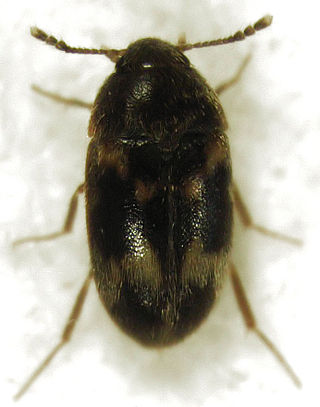
Convolvulaceae, commonly called the bindweeds or morning glories, is a family of about 60 genera and more than 1,650 species. These species are primarily herbaceous vines, but also include trees, shrubs and herbs. The tubers of several species are edible, the best known of which is the sweet potato.

Nyctaginaceae, the four o'clock family, is a family of around 33 genera and 290 species of flowering plants, widely distributed in tropical and subtropical regions, with a few representatives in temperate regions. The family has a distinctive fruit type called an accessory fruit or anthocarp, and many genera have extremely large pollen grains.

The lined antshrike is a species of bird in subfamily Thamnophilinae of family Thamnophilidae, the "typical antbirds". It is found in Colombia, Ecuador, and Peru.

The Mycetophagidae or hairy fungus beetles are a family of beetles in the superfamily Tenebrionoidea. The different species are between 1.0 and 6.5 mm in length. The larvae and adults live in decaying leaf litter, fungi, and under bark. Most species feed on fungi. Worldwide, the 18 genera contain around 200 species.

Papilio phorcas, the apple-green swallowtail or green-banded swallowtail, is a butterfly of the family Papilionidae. It is found in Africa.

iNaturalist is an American 501(c)(3) nonprofit social network of naturalists, citizen scientists, and biologists built on the concept of mapping and sharing observations of biodiversity across the globe. iNaturalist may be accessed via its website or from its mobile applications. iNaturalist includes an automated species identification tool, and users further assist each other in identifying organisms from photographs. As of 9 July 2024, iNaturalist users had contributed approximately 197,660,888 observations of plants, animals, fungi, and other organisms worldwide, and 290,007 users were active in the previous 30 days.

Mycetophagus flexuosus is a species of hairy fungus beetle in the family Mycetophagidae. It is found in North America. Species of host fungi include Pleurotus ostreatus, Trametes versicolor, and Piptoporus betulinus.

Mycetophagus is a genus of hairy fungus beetles in the family Mycetophagidae. There are at least 20 described species in Mycetophagus.
Mycetophagus obsoletus is a species of hairy fungus beetle in the family Mycetophagidae. It is found in North America.

Mycetophagus serrulatus is a species of hairy fungus beetle in the family Mycetophagidae. It is found in North America.

Mycetophagus quadriguttatus, known generally as the spotted hairy fungus beetle or four-spotted fungus beetle, is a species of hairy fungus beetle in the family Mycetophagidae. It is found in Africa, Australia, Europe and Northern Asia, North America, and Southern Asia.
Mycetophagus confusus is a species of hairy fungus beetle in the family Mycetophagidae. It is found in North America.
Mycetophagus pluripunctatus is a species of hairy fungus beetle in the family Mycetophagidae. It is found in North America.
Mycetophagus californicus is a species of hairy fungus beetle in the family Mycetophagidae. It is found in North America.
Chrysotoxum chinook is a species of syrphid fly in the family Syrphidae.
Mycetophagus melsheimeri is a species of hairy fungus beetle in the family Mycetophagidae. It is found in North America.
Mycetophagus pluriguttatus is a species of hairy fungus beetle in the family Mycetophagidae. It is found in North America.
Mycetophagus distinctus is a species of hairy fungus beetle in the family Mycetophagidae. It is found in North America.
Animal Ethics is a nonprofit organization formed to promote discussion and debate around issues in animal ethics and to provide information and resources for animal advocates. They also do outreach work in several countries on the issue of speciesism. Their aim is to create a world where moral consideration is extended to all sentient beings. The organization's website covers topics such as speciesism, sentience, veganism and wild animal suffering and has content translated into several languages.

Mycetina cruciata is a species of beetle belonging to the family Endomychidae. M. cruciata is native to Europe.









